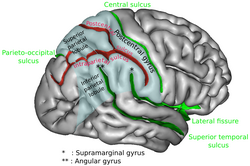Intraparietal sulcus
| Intraparietal sulcus | |
|---|---|

Lateral surface of left cerebral hemisphere, viewed from the side. (Intraparietal sulcus visible at upper right, running horizontally.)
|
|

Right cerebral hemisphere, viewed from the side. The region colored in blue is parietal lobe of the human brain. Intraparietal sulcus runs horizontally at the middle of the parietal lobe.
|
|
| Details | |
| Part of | Parietal lobe |
| Identifiers | |
| Latin | sulcus intraparietalis |
| Acronym(s) | IPS |
| NeuroNames | hier-79 |
| NeuroLex ID | Intraparietal sulcus |
| TA | A14.1.09.127 |
| FMA | 83772 |
|
Anatomical terms of neuroanatomy
[]
|
|
The intraparietal sulcus (IPS) is located on the lateral surface of the parietal lobe, and consists of an oblique and a horizontal portion. The IPS contains a series of functionally distinct subregions that have been intensively investigated using both single cell neurophysiology in primates and human functional neuroimaging. Its principal functions are related to perceptual-motor coordination (e.g., directing eye movements and reaching) and visual attention, which allows for visually-guided pointing, grasping, and object manipulation that can produce a desired effect.
The IPS is also thought to play a role in other functions, including processing symbolic numerical information, visuospatial working memory and interpreting the intent of others.
Five regions of the intraparietal sulcus (IPS): anterior, lateral, ventral, caudal, and medial
All of these areas have projections to the frontal lobe for executive control.
Activity in the intraparietal sulcus has also been associated with the learning of sequences of finger movements.
The task-positive network includes the intraparietal sulcus in each hemisphere; it is one of two sensory orienting systems in the human brain.
Behavioral studies suggest that the IPS is associated with impairments of basic numerical magnitude processing and that there is a pattern of structural and functional alternations in the IPS and in the PFC in dyscalculia. Children with developmental dyscalculia were found to have less gray matter in the left IPS.
Studies have shown that electrical activity in a particular group of nerve cells in the intraparietal sulcus spiked when, and only when, volunteers were performing calculations. Outside experimental settings it was also found that when a patient mentioned a number — or even a quantitative reference, such as “some more,” “many” or “bigger than the other one” — there was a spike of electrical activity in the same nerve-cell population of the intraparietal sulcus that was activated when the patient was doing calculations under experimental conditions.
Lateral surface of left cerebral hemisphere, viewed from above.
Left cerebral hemisphere, viewed from the back. (Intraparietal sulcus visible at top center)
Human brain dissection video (53 sec). Demonstrating position of the intraparietal sulcus of the left cerebral hemisphere.
...
Wikipedia
